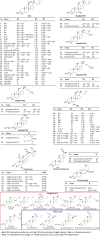A review for discovering bioactive minor saponins and biotransformative metabolites in Panax quinquefolius L
- PMID: 35979234
- PMCID: PMC9376941
- DOI: 10.3389/fphar.2022.972813
A review for discovering bioactive minor saponins and biotransformative metabolites in Panax quinquefolius L
Abstract
Panax quinquefolius L. has attracted extensive attention worldwide because of its prominent pharmacological properties on type 2 diabetes, cancers, central nervous system, and cardiovascular diseases. Ginsenosides are active phytochemicals of P. quinquefolius, which can be classified as propanaxdiol (PPD)-type, propanaxtriol (PPT)-type, oleanane-type, and ocotillol-type oligo-glycosides depending on the skeleton of aglycone. Recently, advanced analytical and isolated methods including ultra-performance liquid chromatography tandem with mass detector, preparative high-performance liquid chromatography, and high speed counter-current chromatography have been used to isolate and identify minor components in P. quinquefolius, which accelerates the clarification of the material basis. However, the poor bioavailability and undetermined bio-metabolism of most saponins have greatly hindered both the development of medicines and the identification of their real active constituents. Thus, it is essential to consider the bio-metabolism of constituents before and after absorption. In this review, we described the structures of minor ginsenosides in P. quinquefolius, including naturally occurring protype compounds and their in vivo metabolites. The preclinical and clinical pharmacological studies of the ginsenosides in the past few years were also summarized. The review will promote the reacquaint of minor saponins on the growing appreciation of their biological role in P. quinquefolius.
Keywords: Panax quinquefolius; metabolites; minor ginsenosides; pharmacological effects; structural diversity.
Copyright © 2022 Yang, Deng, Liu, He, Feng, Liu and Wei.
Conflict of interest statement
The authors declare that the research was conducted in the absence of any commercial or financial relationships that could be construed as a potential conflict of interest.
Figures






References
-
- Cheng L. Q., Na J. R., Kim M. K., Bang M. H., Yang D. C. (2007). Microbial conversion of ginsenoside Rb1 to minor ginsenoside F2 and gypenoside XVII by Intrasporangium sp. GS603 isolated from soil. J. Microbiol. Biotechnol. 17, 1937–1943. - PubMed
Publication types
LinkOut - more resources
Full Text Sources
Miscellaneous

